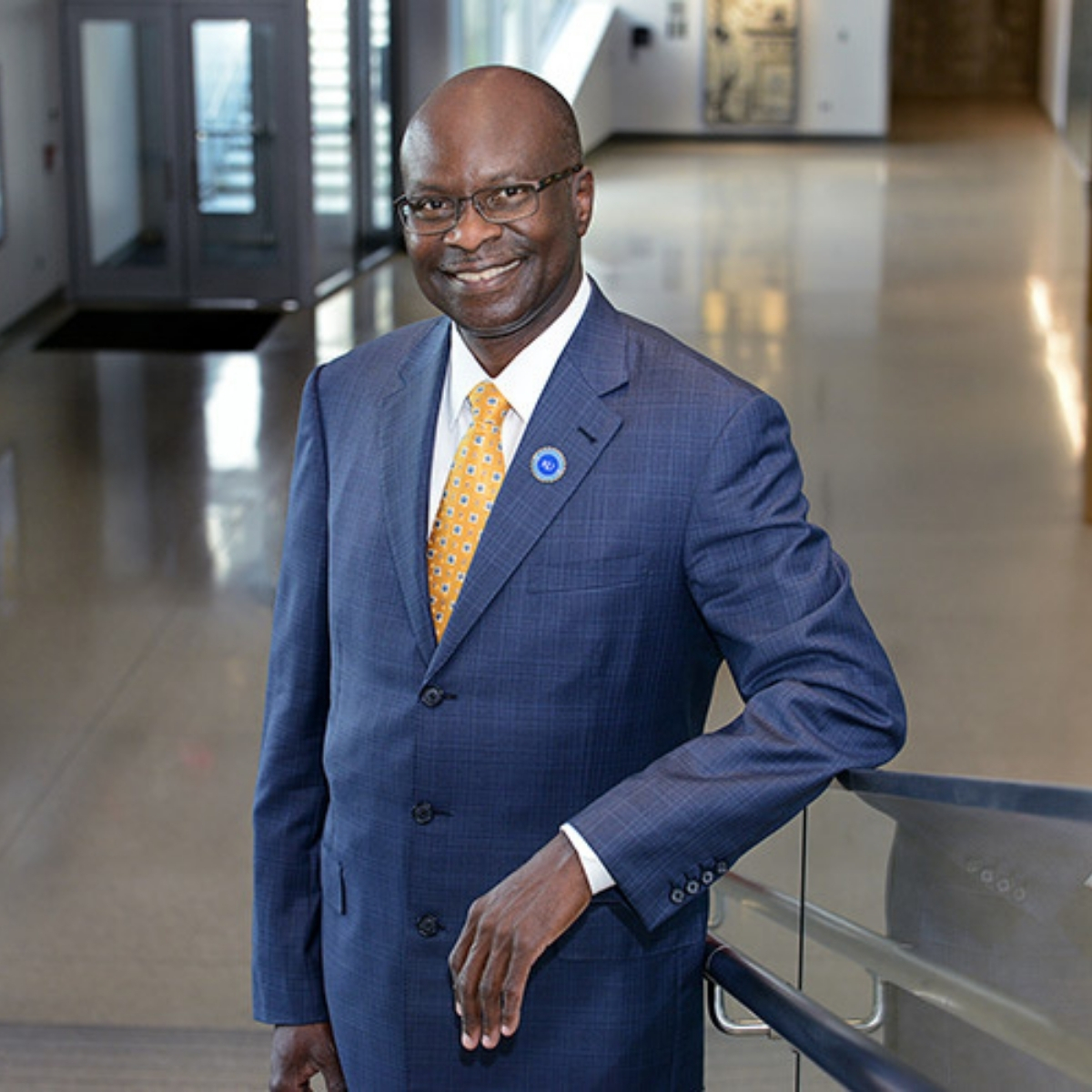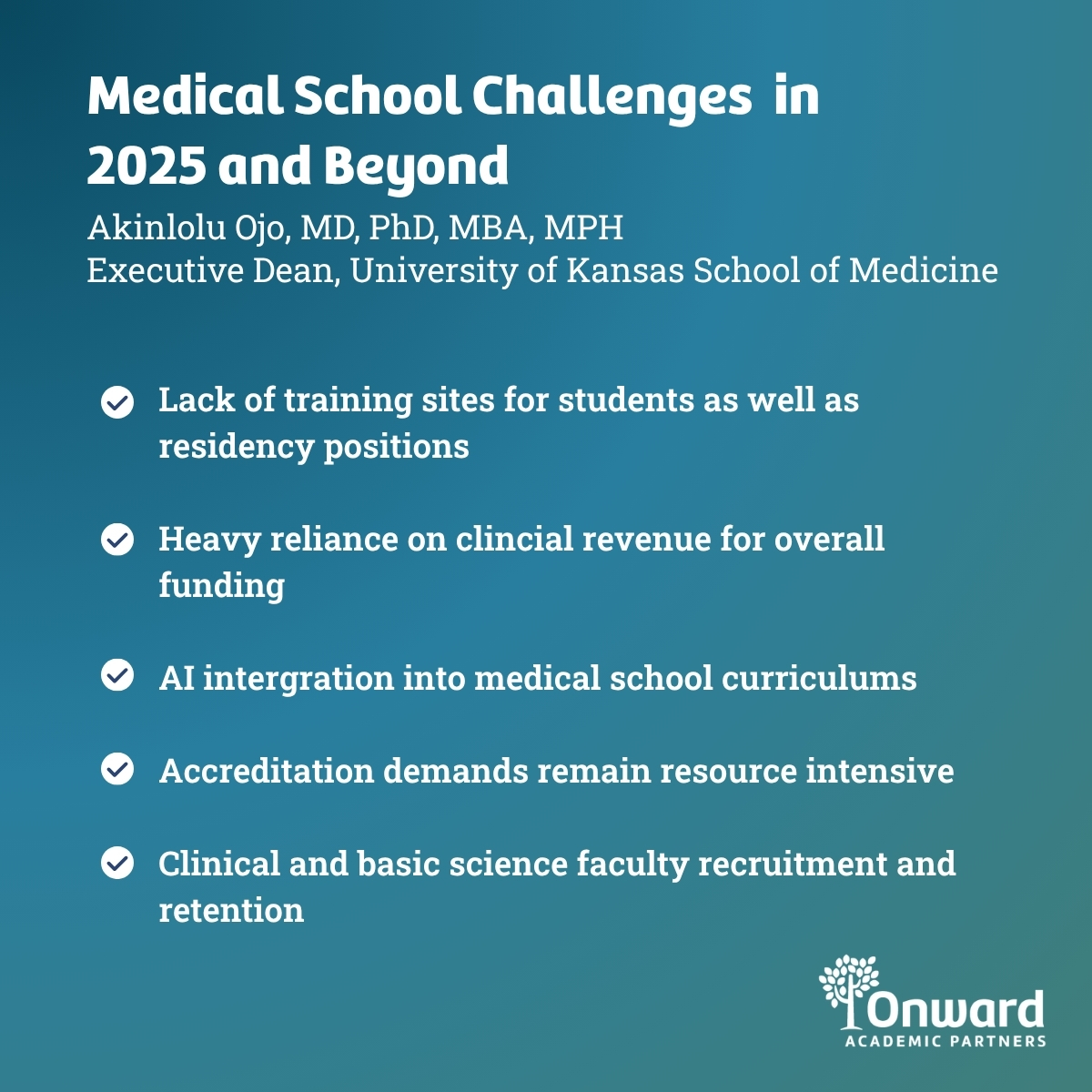Rooted Interests with
Akinlolu Ojo, MD, PhD, MBA, MPH
Akinlolu Ojo, MD, PhD, MBA, MPH
Rooted Interests with
Akinlolu Ojo, MD, PhD, MBA, MPH
Akinlolu Ojo, MD, PhD, MBA, MPH
Medical School Challenges in 2025 and Beyond
Onward Academic Partners recently had the opportunity to speak with with Akinlolu Ojo, MD, PhD, MBA, MPH, who currently serves as the Executive Dean of the University of Kansas School of Medicine.
Dr. Ojo brought a wealth of experience and a deeply informed perspective to the conversation, developed through his extensive background in medicine, research and leadership roles in academic healthcare.
This summary reflects Dr. Ojo’s valuable insights into the complex and evolving challenges facing medical education today. He addressed a range of issues, including workforce planning, revenue and funding. As part of identifying these various challenges, he is committed to growth while also identifying promising opportunities for innovation, collaboration and building a foundation for continuous improvement.

Dr. Akinlolu Ojo
What is the biggest challenge facing medical schools in the next three years?
One of the biggest challenges we face in the near term is a projected shortage of physicians. The U.S. is expected to face an estimated shortage of 80,000 physicians by 2030, affecting both specialists and primary care providers. As a result, I see several ways to structure our approach to reduce the potential impact.
To overcome the forecasted physician shortfall, training enough clinicians is a top challenge, with multiple components:
- Clinical Training Capacity: There has been a rapid increase in the number of medical schools (about 25 new schools in the last decade), but the number of teaching hospitals has not kept pace, leading to competition for clinical training sites among medical students, osteopathic students, physician assistants, and nurse practitioners.
- Preceptor Shortage: This shift often means clinical productivity needs higher prioritization while maintaining high quality research and education..
There are two other important variables related to workforce development that require our attention and thought:
- Osteopathic School Students: Osteopathic schools often have much larger class sizes (250–800 students) compared to allopathic schools (about 110 students), further straining clinical training resources.
- Residency Bottleneck: The number of ACGME residency positions has remained static for about 30 years, despite growing numbers of U.S. and international medical graduates. There are approximately 36,000 applicants for around 20,000–25,000 residency slots annually, resulting in many qualified graduates without positions. (There are about 10,000 foreign medical graduates who are also vying for these residency positions.
Are the other major challenges occurring?
Support for basic research
Clinical research is essential to advancing medicine and patient care. Particularly in an academic environment, physicians view research as a foundational component of growth; they want to be challenged, but we have to find ways to support them in their efforts.
- There is declining support for physician-scientists and basic science researchers.
- Fewer physicians are pursuing research careers, and an increasing number of PhDs are moving into the pharmaceutical industry rather than academic research.
- The foundation of biomedical discovery is being eroded, likened to “termites destroying the framework of a house”—damage that may not be obvious until it is too late to repair.
AI integration in healthcare and education
- The rapid adoption of AI in healthcare presents two main challenges:
- Preparing Students: Ensuring graduates are competent in using AI tools at the bedside from the start of residency.
- Using AI in Teaching: Incorporating AI as an educational tool within the curriculum.
- Most medical schools, except for a few elite institutions (e.g., NYU, Harvard, Columbia, Michigan), lack the financial resources and staffing to integrate AI into their programs.
- There is a high risk of graduating students who are not adequately prepared to use AI in clinical practice.
How does the funding structure impact medical schools and research?
History tells us there are major shiftings in funding over time. We need to be thoughtful of these funding shifts and resulting impact on revenue, research, budgets and workforce planning. Historically, public medical schools received about 40% of funding from state governments, 40% from research, and 20% from clinical care. Now, 65–70% of funding comes from the clinical enterprise (health system), making medical schools highly dependent on clinical revenue. This shift means clinical productivity is often prioritized, despite the increasing demands of our teaching and research missions.
How do accreditation requirements affect medical schools?
Accreditation requirements play a significant role in shaping how medical schools operate and evolve. These standards ensure a consistent level of quality in medical education, but can also create pressure on institutions to meet extensive documentation, curriculum and faculty demands. For schools committed to research and innovation, balancing accreditation compliance with supporting clinical research can be challenging as you manage resources.
- LCME Accreditation Standards
- The Liaison Committee on Medical Education (LCME) sets 12 standards broken into 96 elements that schools must meet for accreditation.
Diversity Requirement (Element 3.3) previously required medical schools to have specific diversity goals in admissions, which conflicted with laws in at least 20 states prohibiting consideration of race or ethnicity. This conflict was recently resolved when the LCME removed Element 3.3, but it had been a significant compliance challenge.

What are the complexities and benefits of operating a multicampus medical school?
Faculty in high-volume clinical environments have less time for teaching, leading to lower student satisfaction and challenges in providing comparable clinical education. Despite challenges, multicampus models and innovative approaches can offer significant benefits to students and the state.
- Advantages
- Multicampus structure allows training in diverse environments (urban academic centers and small regional hospitals), enriching the educational experience.
- Provides opportunities for rural training, supporting the state’s healthcare needs, especially in rural counties.
- Encourages healthy competition among faculty and campuses, driving improvements in teaching and student satisfaction.
- Challenges
- Ensuring comparable educational experiences and assessments across campuses is difficult. For example, a Department can have a 95% clerkship satisfaction at one campus and 25% satisfaction for the same clerkship at another campus. There can be several reasons for this variance and a solution at one campus may not be appropriate for another.
- The LCME requires proof of comparability, and multicampus schools are often cited for deficiencies in this area.
- Administrative and curricular complexity increases, requiring significant resources for monitoring and quality assurance.

Rooted Insights is an engaging interview series that brings you candid conversations with some of the most dynamic leaders in academic medical administration. Over the years, I’ve had the privilege of learning from and collaborating with these remarkable individuals, and now, we’re sharing their insights and experiences directly with you.
Each interview offers a concise yet impactful perspective on timely and relevant issues in their area of expertise across academic medicine. Whether seeking new ideas, professional inspiration, or development guidance, these conversations are designed to spark your curiosity.
If you’d like to dive deeper, please contact me directly and we can continue the conversation.
Sit back and enjoy this series!

